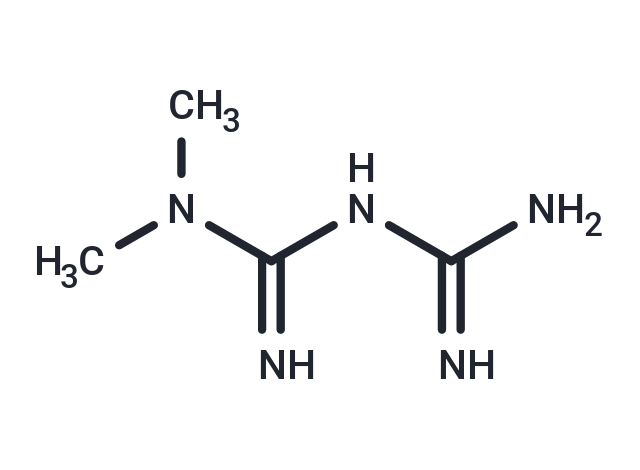Shopping Cart
Remove All Your shopping cart is currently empty
Your shopping cart is currently empty
Metformin (1,1-Dimethylbiguanide) is an AMPK activator with blood-brain barrier permeability. Metformin may improve glycemic control by increasing insulin sensitivity and decreasing intestinal glucose uptake, and is commonly used in type 2 diabetes research.

| Pack Size | Price | USA Warehouse | Global Warehouse | Quantity |
|---|---|---|---|---|
| 10 mg | $39 | In Stock | In Stock | |
| 25 mg | $64 | In Stock | In Stock | |
| 50 mg | $89 | In Stock | In Stock | |
| 100 mg | $109 | In Stock | In Stock | |
| 500 mg | $277 | In Stock | In Stock | |
| 1 mL x 10 mM (in DMSO) | $39 | In Stock | In Stock |
| Description | Metformin (1,1-Dimethylbiguanide) is an AMPK activator with blood-brain barrier permeability. Metformin may improve glycemic control by increasing insulin sensitivity and decreasing intestinal glucose uptake, and is commonly used in type 2 diabetes research. |
| Targets&IC50 | PANC1 cells viability:20.95 ± 0.98 mM, B-CPAP cells viability:5.329 mM, SARS-CoV-2 (Calu3 cells):0.4 mM, SARS-CoV-2 (Caco2 cells):1.43 mM, TNF-α:3.35 μM |
| In vitro | METHODS: Ovarian cancer cells A2780 and SKOV3 were treated with Metformin (0.001-50 mM) for 24-48 h. Cell viability was assayed using the MTS RESULTS: Micromolar concentrations of Metformin did not statistically reduce the viability of the A2780 or SKOV3 cell lines. At 48 h, millimolar concentrations resulted in cell death. [1] METHODS: Human colorectal cancer cells HCT29 were treated with Metformin (0.6 mM) for 90 h. Cell motility was detected using the wound healing assay and chamber invasion assay. RESULTS: Metformin inhibited the migration and invasion of HCT29 cells, and Metformin decreased the motility of tumor cells. [2] |
| In vivo | METHODS: To model Metformin-induced diarrhea, Metformin (125-500 mg/kg) was administered orally to healthy and diabetic obese db/db C57BL/6J mice twice daily for thirteen days. RESULTS: Metformin at 1000 mg/kg/day significantly increased fecal water content. Although no diarrhea symptoms were observed in healthy C57BL/6J mice, the same dose of Metformin induced severe diarrhea in diabetic obese db/db mice. [3] METHODS: To investigate the protective effect of Metformin in radiation injury, Metformin (200 mg/kg once daily for three days) was administered orally to BALB/c mice, which were then exposed to 6-8 Gy of gamma radiation. RESULTS: When administered prior to exposure to radiation, Metformin prolonged the survival of mice exposed to 8 Gy-TBI and increased the survival of mice exposed to 6 Gy-TBI. Pretreatment with Metformin attenuated radiation damage. [4] |
| Synonyms | 1,1-Dimethylbiguanide |
| Molecular Weight | 129.16 |
| Formula | C4H11N5 |
| Cas No. | 657-24-9 |
| Smiles | CN(C)C(=N)NC(N)=N |
| Relative Density. | 1.0743 g/cm3 (Estimated) |
| Storage | store at low temperature,keep away from direct sunlight,store under nitrogen | Powder: -20°C for 3 years | In solvent: -80°C for 1 year | Shipping with blue ice/Shipping at ambient temperature. | |||||||||||||||||||||||||||||||||||
| Solubility Information | DMSO: 49 mg/mL (379.37 mM), Sonication and heating are recommended. H2O: 100 mg/mL (774.23 mM), Sonication is recommended. | |||||||||||||||||||||||||||||||||||
| In Vivo Formulation | 10% DMSO+40% PEG300+5% Tween 80+45% Saline: 2 mg/mL (15.48 mM), Sonication is recommended. Please add the solvents sequentially, clarifying the solution as much as possible before adding the next one. Dissolve by heating and/or sonication if necessary. Working solution is recommended to be prepared and used immediately. The formulation provided above is for reference purposes only. In vivo formulations may vary and should be modified based on specific experimental conditions. | |||||||||||||||||||||||||||||||||||
Solution Preparation Table | ||||||||||||||||||||||||||||||||||||
DMSO/H2O
| ||||||||||||||||||||||||||||||||||||
| Size | Quantity | Unit Price | Amount | Operation |
|---|

Copyright © 2015-2025 TargetMol Chemicals Inc. All Rights Reserved.